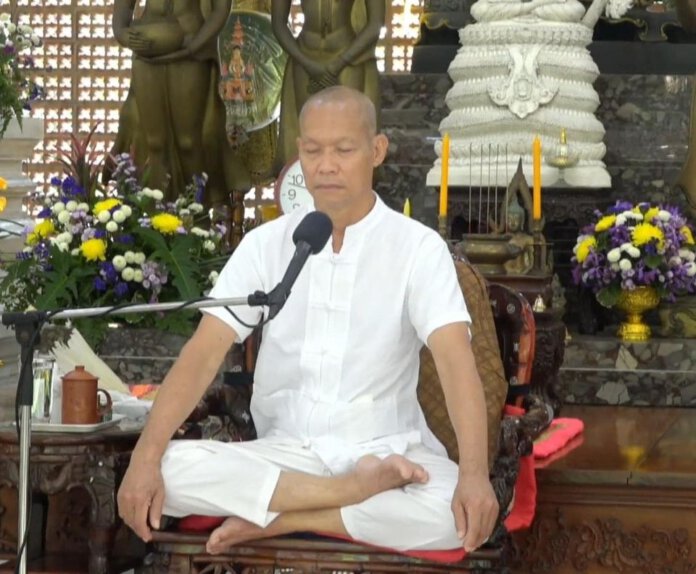อธิบายคำว่านิพพาน หมายถึง ความดับ ความเย็น จนไม่เหลือเชื้อความปราศจาก ความหลุดพ้น ความถอดถอนรากเหง้า ความขาดสูญ ความหมดสิ้นแล้วซึ่งตัณหาและอาสวะทั้งปวง
อธิบายคำว่า ทำให้แจ้ง หมายถึง การทำความเข้าใจ การเข้าไปใกล้ การได้สัมผัส การทดลองพิสูจน์จนสิ้นสงสัย
บุคคล ๔ ประเภท ที่สามารถบรรลุถึงนิพานได้มีดังนี้ คือ
๑. โสดาบัน หมายถึง ผู้เข้าถึงกระแสธรรม ผู้ไม่หลงทาง ผู้แรกถึงกระแสธรรม (คืออริยมรรค) ผู้ละสังโยชน์ เครื่องผูกรัดได้ ๓ ประการ คือ
๑. สักกายทิฏฐิ คือ ความเห็นเป็นเหตุถือตัวตน เช่นเห็นว่ากายนี้ใจนี้เป็นตัวตนของเรา
๒. วิจิกิจฉา คือ ความลังเลสงสัย เช่นสงสัยในข้อปฏิบัติ ของตนที่ปฏิบัติตามวิถีแห่งอริยมรรคว่าถูกต้องหรือไม่ สงสัยในพระรัตนตรัยหรือในอริยสัจ ๔ ว่ามีจริงหรือไม่
๓. สีลัพพตปรามาส คือ ความเชื่อถือยึดมั่นว่าความวิเศษศักดิ์สิทธิ์มีได้ด้วยศีลและพรตที่ตนมี
๒. สกทาคามี หรือ สกิทาคามี หมายถึง ผู้กลับมาเกิดเพียงครั้งเดียว ผู้ไม่มีภพชาติที่ ๒ นอกจากละสังโยชน์ ๓ ได้แล้วยังทำสังโยชน์เบื้องต่ำอีกสองประการที่เหลือให้เบาบางลงด้วยคือ
กามราคะ หมายถึง ความพึงพอใจ เพลินในการได้เสพ รูป รส กลิ่น เสียง สัมผัส ธรรมารมณ์ ที่น่าพอใจ
ปฏิฆะ หมายถึง ความกระทบกระทั่งในใจ คล้ายความพยาบาทอย่างละเอียด
๓. อนาคามี หมายถึง ผู้ไม่มาเกิดอีก หมายความว่าจะไม่กลับมาเกิดในกามาวจรภพอีก แต่จะเกิดใน พรหมโลก อีกเพียงครั้งเดียว แล้วจะนิพพานในพรหมโลกนั้นเลยเป็นผู้ละสังโยชน์เบื้องต่ำ (โอรัมภาคิยสังโยชน์) ทั้ง ๕ ประการได้หมดแล้ว
๔. อรหันต์ คือ ผู้สำเร็จธรรมวิเศษสูงสุดในพระพุทธศาสนา พระอริยบุคคลชั้นสูงสุด สามารถละสังโยชน์ได้ครบ ๑๐ ประการ ซึ่งอีก ๕ ประการ คือ
๑. รูปราคะ หมายถึง ความพอใจในรูปฌาน หรือ รูปธรรมอันประณีต หรือ ความพอใจในรูปภพ
๒. อรูปราคะ หมายถึง ความพอใจในอรูปฌาน หรือ พอใจในอรูปธรรม เช่น ความรู้ เป็นต้น หรือ ความพอใจในอรูปภพ
๓. มานะ หมายถึง ความสำคัญตนว่าเป็นนั่นเป็นนี่ เช่น เป็นพระอนาคามี (แม้ว่าจะเป็นจริงๆ) เป็นต้น
๔. อุทธัจจะ คือ ความฟุ้งของจิต
๕. อวิชชา คือ ความไม่รู้แจ้ง
นิพพาน มี ๒ ประเภท คือ
๑. สอุปาทิเสสนิพพาน หมายถึง ผู้หมดสิ้นขาดสูญจากตัณหา อาสวกิเลสทั้งปวงแล้ว แต่ยังมีชีวิตอยู่
๒. อนุปาทิเสสนิพพาน หมายถึง ผู้หมดสิ้นขาดสูญจากตัณหา อาสวกิเลสทั้งปวงแล้ว แต่ไม่มีชีวิตอยู่
ท่านใดเมื่อทำนิพพานให้แจ้งแล้ว จักได้ผลดังนี้คือ
๑. ทำให้จิตไม่หวั่นไหวในโลกธรรม
๒. ทำให้จิตไม่โศก
๓. ทำให้จิตปราศจากธุลี
๔. ทำให้จิตเกษม
เอตัมมังคะละมุตตะมัง ข้อนี้เป็นมงคลอันสูงสุด
พุทธะอิสระ
๑๒ กรกฎาคม ๒๕๖๔
————————————————–
Attainment of nirvana
July 12, 2021
Nirvana means extinction, coolness, liberation, uprooting, extinction and disappearance of all desires and mental intoxication.
Attainment of enlightenment means understanding, getting close to, experiencing, and experimenting to clear one’s doubt.
Four types of persons who can attain nirvana are as follows.
1. Stream-Enterer means one who has attained the first stage of holiness. Person who is not lost. The first person who has attained the stream of Dharma (the Noble Eightfold Path). Person who can abandon the following three fetters that bind man to the round of rebirth.
1. Self-illusion means one thinks that one’s body and mind belong to oneself.
2. Skepticism means doubt in practice whether one’s practice is correct according to the Noble Eightfold Path and doubt whether the Triple Gem or the Four Noble Truths really exist.
3. Adherence to mere rule and ritual
2. Once-Returner; one who will be reborn on the earth only once before attaining the final emancipation. One who can abandon the mentioned three fetters that bind man to the round of rebirth. One who can lessen the other following two basic fetters.
Sensual passion means satisfaction from pleasing objects, taste, scent, sound, tough and cognizable objects.
Repulsion means resentment like delicate vengeance.
3. Never-Returner means person who is never born as human or angels. Person will be born one more time as Brahman and will attain nirvana. One who has already abandoned the five fetters that bind man to the round of rebirth.
4.Arahant means person who has attained the most noble Buddhist Dharma. One who can abandon all ten fetters that bind man to the round of rebirth. The rest of five fetters that an Arahant can abandon are as follows.
1. Desire for life in the world of form means satisfaction in Jhanas (Absorptions) of the Fine-material Sphere or satisfaction for the life of Brahman who has physical body.
2. Desire for life in the formless worlds means satisfaction in the four Absorptions of the Formless Sphere or abstract object such as knowledge or satisfaction for the life of Brahman who is formless.
3. Conceit or pride of one’s being such as being a Never-Returner (even though one really is)
4. Restlessness means mental distraction
5. Ignorance means lack of knowledge and delusion
There are two types of nirvana as follows.
1. Nirvana with the substratum of life remaining means one no longer has any desire or defilement, but one is still alive.
2. Nirvana without any remainder of physical existence means one no longer has any desire or defilement, and one is not alive.
Those who have attained nirvana will have following outcome.
1. One’s mind is not wavered by worldly conditions.
2. One’s mind is not sorrowful.
3. One’s mind is without any impurity.
4. One’s mind is at profound peace.
Buddha Isara







